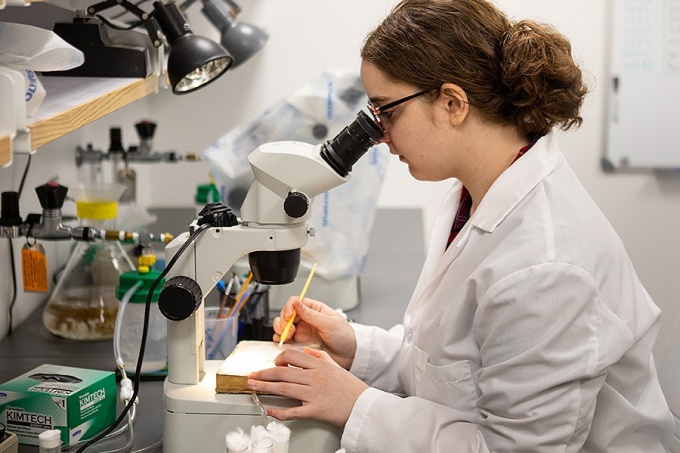Gunawardena Lab is featured by UB Seen

Kelsey Swinter, a master’s student in biological sciences, examines fruit flies through a microscope.
How does a fruit fly teach us about Alzheimer’s Disease?
Shermali Gunawardena's research focuses on how genetic mutations in the fruit fly can lead to “traffic jams” in the brain's transport system. Some scientists think such blockages may precede formation of plaques in certain neurological disorders. Gunawardena's work aims to inform new avenues for treating or preventing diseases such as Alzheimer’s. The Gunawardena Lab is now featured in a slideshow by UB Seen.
Where fruit flies aren’t pests
When it comes to genetics research, tiny fruit flies can teach us a lot. Studies on these insects have led to many important medical discoveries. At UB, biologist Shermali Gunawardena uses fruit flies as a simple model organism to learn about neurodegenerative diseases. Her team is interested in how vital materials are transported from one part of a brain cell to another — and what happens when this transport system goes awry. Photos: Douglas Levere
Published April 3, 2019 This content is archived.
Faculty Profile
![Shermali Gunawardena.]()
Shermali Gunawardena
PhD
Research Interests
Axonal transport and neurodegenerative disease
Education
- PhD, University of Arizona
- Postdoctoral Research, University of California, San Diego
Research Summary
Within axons vital cargoes must be transported over great distances along microtubule tracks to maintain cell viability. In neuronal cells, many proteins function in sending and receiving messages, cell repair, and cell protection. My interest is to elucidate if degeneration of neurons in two neurodegenerative diseases (Alzheimer’s disease or Huntington’s/other polyQ diseases), is related to a defect in this long distance transport system and what mechanisms facilitate the normal transport of APP and huntingtin.
- Gunawardena featured on NPR's Academic Minute Radio: Neuronal Blockages and Alzheimer’s: How traffic moves along the neuronal highways in the brain. Northeast Public Radio, NPR-WAMC.
In the News
Selected Publications
- Krzystek, T. J, Gunawardena, S. (2025). Navigating the neuronal recycling bin: Another look at huntingtin in coordinating autophagy. Autophagy Reports, 4(1). Jun 2 https://doi.org/10.1080/27694127.2025.2472450
- Krzystek TJ, Rathnayake R, Zeng J, Huang J, Iacobucci G, Yu MC, Gunawardena S. (2025) Opposing roles for GSK3β and ERK1-dependent phosphorylation of huntingtin during neuronal dysfunction and cell death in Huntington's disease. Cell Death Dis. Apr 22;16(1):328. doi: 10.1038/s41419-025-07524-0.
- Gunawardena S. (2024), Alpha-synuclein in mitochondrial dysfunction: Opportunities or obstacles. Neural Regeneration Research 10.4103/NRR.NRR-D-23-01966, April 03, 2024. doi: 10.4103/NRR.NRR-D-23-01966.
- Swinter K, Salah D, Rathnayake R, Gunawardena S. (2023) PolyQ-expansion causes mitochondria fragmentation independent of huntingtin and is distinct from traumatic brain injury (TBI)/mechanical stress-mediated fragmentation which results from cell death. Cells. 2023; 12(19):2406.
https://doi.org/10.3390/cells12192406 - Banerjee R and Gunawardena S (2023), Glycogen synthase kinase 3β (GSK3β) and presenilin (PS) are key regulators of kinesin-1-mediated cargo motility within axons. Front. Cell Dev. Biol. 11:1202307. doi: 10.3389/fcell.2023.1202307
- Krzystek TJ, White JA, Rathnayake R, Thurston L, Hoffmar-Glennon H, Li Y, Gunawardena S. (2022) HTT (huntingtin) and RAB7 co-migrate retrogradely on a signaling LAMP1-containing late endosome during axonal injury. Autophagy. Sep 9:1-22. doi: 10.1080/15548627.2022.2119351. PMID: 36048753.
- Banerjee R, Chakraborty P, Yu MC, Gunawardena S (2022). A stop or go switch: glycogen synthase kinase 3β phosphorylation of the kinesin 1 motor domain at Ser314 halts motility without detaching from microtubules. Development. 148(24):dev199866. doi: 10.1242/dev.199866. Epub 2021 Dec 23. PMID: 34940839.
- Krzystek, T.J*., Banerjee, R*., Thurston, L., Huang, JQ., Swinter, K.,Rahman, S.N., Falzone, T.F., Gunawardena, S. (2021) Differential mitochondrial roles for α-synuclein in DRP1-dependent fission and PINK1/Parkin-mediated oxidation. Cell Death Dis 12, 796. doi.org/10.1038/s41419-021-04046-3. *Co-first authors.
- White II JA*, Krzystek TJ*, Hofmar-Glennon H, Thant C, Zimmerman K, Iacobucci G, Vail J, Thurston L, Rahman SN, Gunawardena S. (2020) Excess Rab4 rescues synaptic and behavioral dysfunction caused by defective HTT-Rab4 axonal transport in Huntington's disease. Acta Neuropathol Commun. Jul 1;8(1):97. doi: 10.1186/s40478-020-00964-z. *Co-first authors
- Anderson EN, Hirpa D, Zheng KH, Banerjee R and Gunawardena S. (2020) The non-amyloidal component region (NAC) of α-synuclein is important for α-synuclein transport within axons. Frontiers in Cellular Neuroscience.
- Banerjee R, White JA II, Gunawardena S. (2020). In vivo visualization of moving synaptic cargo complexes within Drosophila larval segmental axons. Methods Mol Biol. 2020; 2143:293-300. doi: 10.1007/978-1-0716-0585-1_21.
- Hansen TM*, Thant C*, White II JA‡ Banerjee R‡, Thuamsang B, Gunawardena S. (2019). Excess active P13K rescues Huntingtin-mediated neuronal cell death but has no effect on axonal transport defects. Apoptosis. Feb 6. doi: 10.1007/s10495-019-01520-4. *Co-first authors, ‡Co-second authors.
- Banerjee R, Rudloff Z, Naylor C, Yu M, Gunawardena S. (2018) The Presenilin loop region is essential for Glycogen synthase kinase 3 beta mediated functions on motor proteins during axonal transport. Hum Mol Genet. 2018 May 22. doi: 10.1093/hmg/ddy190.
- Iacobucci GJ, Gunawardena S. (2017) Ethanol stimulates the in vivo axonal movement of neuropeptide dense-core vesicles in Drosophila motor neurons. J Neurochem. 2017 Sep 28. doi: 10.1111/jnc.14230. Link.
- White JA 2nd, Banejee R, Gunawardena S (2016). Axonal transport and neurodegenerative disease: How marine drugs can be used a therapeutics. Marine Drugs. 19;14(5). pii: E102.
- Xu W, Weissmiller AM, White JA 2nd, Fang F, Wang X, Wu Y, Pearn ML, Zhao X, Sawa M, Chen S, Gunawardena S, Ding J, Mobley WC, Wu C. (2016) Amyloid precursor protein-mediated endocytic pathway disruption induces axonal dysfunction and neurodegeneration. J Clin Invest. Apr 11. pii: 82409. doi: 10.1172/JCI82409.
- White II JA, Anderson E, Zimmerman K, Zheng K, Rouhani R, Gunawardena S. (2015) Huntingtin differentially regulates the axonal transport of a sub-set of Rab-containing vesicles in vivo. Human Molecular Genetics. News Link
- Kang MJ, Hansen TJ, Michiewicz M, Kaczynski TJ, Fye S, Gunawardena S. (2014) Disruption of axonal transport perturbs bone morphogenetic protein (BMP)- signaling and contributes to synaptic abnormalities in two neurodegenerative diseases. PLoS ONE. Aug 15;9(8):e104617. doi: 10.1371/journal.pone.0104617.
- Ehaideb SN, Iyengar A, Ueda A, Iacobucci GJ, Cranston K, Bassuk AG, Gubb D, Axelrod JD, Gunawardena S,Wu C, Manak JR. (2014) prickle modulates microtubule polarity and axonal transport to ameliorate seizures in flies. Proc Natl Acad Sci U S A. Jul 29;111(30):11187-92. doi: 10.1073/pnas.1403357111.
- Iacobucci GJ, Rahman NA, Valtueña AA, Nayak TK, Gunawardena S. (2014) Spatial and temporal characteristics of normal and perturbed vesicle transport. PLoS ONE. May 30;9(5):e97237 News Link
- Anderson EN*, White JA 2nd*, Gunawardena S. (2014) Axonal transport and neurodegenerative disease: Vesicle-motor complex formation and their regulation. Degenerative Neurological and Neuromuscular Disease 4:29-47. * contributed equally to this work.
- Dolma K, Iacobucci GJ, Zheng KH, Shandilya J, Toska E, White JA 2nd, Spina E, Gunawardena S. (2013) Presenilin influences Glycogen Synthase Kinase-3beta (GSK-3β) for kinesin-1 and dynein function during axonal transport. Hum Mol Genet. 2013 Oct 8.
- Gunawardena S.*, Yang G, Goldstein LSB. (2013) Presenilin controls kinesin-1 and dynein activity during axonal transport. Human Molecular Genetics Jun 6 10.1093/hmg/ddt237, *corresponding author. Newslink.
- Gunawardena S. (2013) Nanoparticles in the brain: A Potential therapeutic system targeted to an early defect observed in many neurodegenerative diseases. Pharmaceutical Research Apr 27 10.1007/s11095-013-1037-0
- Gunawardena S (2012) Developing nanotherapies for neurodegenerative diseases: ORMOSIL and its potential in axonal transport. Ther Deliv. 2012 Oct;3(10):1189-98.
- Power D, Srinivasan S, Gunawardena S .(2012)In-vivo evidence for the disruption of Rab11 vesicle transport by loss of huntingtin. Neuroreport. 2012 Nov 14;23(16):970-7.
- Barandeh F, Nguyen PL, Kumar R, Iacobucci GJ, Kuznicki ML, Kosterman A, Bergey EJ, Prasad PN, Gunawardena S. (2012) Organically modified silica nanoparticles are biocompatible and can be targeted to neurons in vivo. PLoS One. 2012;7(1):e29424. News Link.
- Kaczynski, T.J., Gunawardena S. (2010) Visualization of the embryonic nervous system in whole-mount Drosophila embryos. J Vis Exp Dec 11;(46). pii: 2150. doi: 10.3791/2150
- Kuznicki, M.L., Gunawardena, S. (2010) In vivo visualization of synaptic vesicles within Drosophila larval segmental axons. J Vis Exp Oct 15;(44). pii: 2151. doi: 10.3791/2151
- Fye, S., Dolma, K., Kang, M.J., Gunawardena, S. (2010) Visualization of larval segmental nerves in 3rd instar Drosophila larval preparations. J Vis Exp. Sep 29;(43). pii: 2128. doi: 10.3791/2128
- Falzone T. L., Gunawardena S., McCleary D., Reis G., Goldstein L.S.B. (2010) Kinesin-1 transport reductions enhance human tau hyperphosphorylation, aggregation and neurodegeneration in animal models of taupathies. Hum Mol Genet 19:4399-408.
- Stokin, G.B., Almenar-Queralt, A., Gunawardena S., Rodrigues, E.M., Lillo, C., Mount, S.L., Roberts, E.A., Williams, D.S., Goldstein, L.S.B. (2008) Presenilin-medated suppression of amyloid precursor protein-induced axonopathies. Hum Mol Genet 17(22):3474-86.
- Gunawardena, S. and Goldstein, L.S.B. (2005) ‘Polyglutamine diseases and transport problems: Deadly traffic jams on neuronal highways’. Archives of Neurology 62:46-51.
- Gunawardena, S. and Goldstein, L.S.B. (2004) ‘Cargo carrying motor vehicles on the neuronal highway: Transport pathways and neurodegenerative disease’. Journal of Neurobiology 58:258-71.
- Gunawardena, S., Her, L., Laymon, R.A., Brusch, R.G., Niesman, I.R., Sintasath, L., Bonini, N.M., and Goldstein, L.S.B. (2003) Disruption of axonal transport by loss of huntingtin or expression of poly Q protein in Drosophila. Neuron 40:25-40. (see accompanying “Previews” in same issue).
- Gunawardena, S. and Goldstein, L.S.B. (2001) Disruption of axonal transport and neuronal viability by amyloid precursor protein mutations in Drosophila. Neuron 32:389-401.
- Goldstein, L.S.B. and Gunawardena, S. (2000) Flying through the Drosophila cytoskeletal genome. Journal of Cell Biology 150:F63-F68.
- Gunawardena, S. and Rykowski, M.C. (2000) Direct evidence for interphase chromosome movement during the mid-blastula transition in Drosophila. Current Biology 10: 285-288.
- Gunawardena, S., Heddle, E and Rykowski, M. (1995) “Chromosomal Puffing” in diploid nuclei of Drosophila melanogaster. Journal of Cell Science 108: 1863-1872.
- Gunawardena, S. and Rykowski, M. (1994) Looking at diploid interphase chromosomes. Methods in Cell Biology 44: 393-409.








